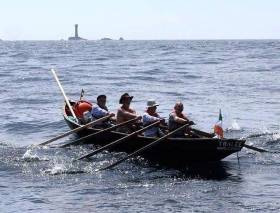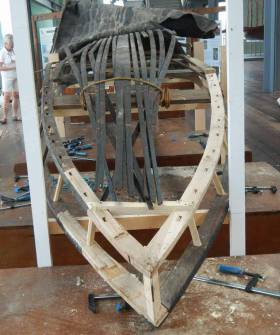Displaying items by tag: naomhog
Naomhóg Rowers Star in Tarrac Due for Broadcast on TG4
A drama which involves a group of female rowers training in the Atlantic off the Kerry Gaeltacht will have its first television screening on TG4 this month.
Tarrac, which involves rowers Rachel Feeney, Kate Finegan, Kate Nic Chonaonaigh, and Kelly Gough, is set on the Dingle peninsula.
Directed by Declan Recks, the plot centres on Aoife Ní Bhraoin, who returns home to help her father, Brendán ‘The Bear’ Ó Briain, recover from a heart attack.
While trying to deal with her mother’s death, she re-acquaints herself with home through her involvement with a naomhóg crew.
As previously reported by Afloat, the drama had its debut at the 2022 Galway Film Fleadh.
 Tarrac is a TG4 drama which involves a group of female rowers training in the Atlantic off the Kerry Gaeltacht
Tarrac is a TG4 drama which involves a group of female rowers training in the Atlantic off the Kerry Gaeltacht
The Irish language feature film was produced by Icebox Films with funding from TG4’s Cine4 scheme, Fís Éireann/Screen Ireland and Coimisiún na Meán.
The script was written by Eugene O’Brien and the film was produced by Clíona Ní Bhuachalla.
Cast includes Kelly Gough, Lorcan Cranitch, Kate Nic Chonaonaigh, Kate Finegan, Rachel Feeney and Cillian Ó Gairbhí.
Tarrac will be broadcast on TG4 and TG4.ie on Monday, March 18th, 2024,at 9.30pm.
A Medieval Galician poem is being re-imagined as a homage to the late Kerry sailor, poet and boatbuilder Dómhnall Mac an tSíthigh.
Mac an tSíthigh, also known as Danny Sheehy, died after a naomhóg in which he was one of four crew capsized off the Iberian coast in June 2017
The four were participants on Iomramh an Chamino 2017, which had left the Spanish port of La Coruña in late May bound for the Portuguese city of Porto in late June.
Internationally acclaimed singer and musician Liam Ó Maonlaí, renowned traditional singer and instrumentalist Breanndán Ó BeaglaoichSpanish-Czech singer Katerina García, and award-winning cinematographer Jaro Waldeck are among participants in an audio-visual project taking place in Dublin this Thursday, October 26th.
Cantiga I / Tonnta Farraigí Vigo is based on new interpretations and re-imaginings of the iconic Mediaeval Galician poem “Ondas do mar de Vigo” (“Cantiga I”) by Galician poet Martín Codax (mid-13th c).
It is described as the first of seven extant poetic compositions in the genre of cantigas d’amigo (songs/poems of the beloved) attributed to the poet and found in the manuscript Pergamino Vindel, now in The Morgan Library and Museum, New York (Vindel MS M979).
In this project, the original Galician text is presented for the first time alongside, and in dialogue with, its translation into Irish, by Ó Beaglaoich
This project takes place in Instituto Cervantes, Lincoln Place, Dublin, and it is co-funded by the Trinity Arts and Social Sciences Benefactions Fund. It is supported by the Department of Tourism, Culture, Arts, Gaeltacht, Sport and Media.
Full details are here
Four Irish Men Take Kerry Naomhóg Across Cape Breton
When Kerry Blasket islanders built the naomhóg for fishing, they would never have dreamed the same craft might transit Nova Scotia writes Lorna Siggins
However, four Irishmen have now rowed and sailed a similar design across Cape Breton in northern Canada.
The voyage has been undertaken by musician Breanndán Ó Beaglaoich, fellow Kerrymen Eamonn O Muircheartaigh and Seán Mac an tSíthigh and Kilkenny-based artist Liam Holden.
The 8-metre craft was constructed in Cape Breton last year as part of a Celtic Colours International Festival, Ó Beaglaoich explains.
 (Above and below) The 8-metre naomhóg has been rowed and sailed across Nova Scotia's Cape Breton by a four-man Irish crew
(Above and below) The 8-metre naomhóg has been rowed and sailed across Nova Scotia's Cape Breton by a four-man Irish crew

Nova Scotia artist Rosie MacKenzie issued the invitation to Ó Beaglaoich, who, with Holden, completed the “Camino by sea” voyage from Ireland to Spain between 2014 and 2016 in a Kerry naomhóg.
That three-summer voyage in the Naomh Gobnait involved Kerry poet Danny Sheehy, Breandán Moriarty and musician Glen Hansard, and Sheehy died the following year during a continuation of the journey to the Portuguese border.
Sean Mac an tSíthigh, an RTÉ and TG4 journalist on this Nova Scotia crew, is a nephew of the Kerry poet.
 Naomhóg crewman Sean Mac an tSíthigh (left) with Nova Scotia lightkeepers grandson John Murray
Naomhóg crewman Sean Mac an tSíthigh (left) with Nova Scotia lightkeepers grandson John Murray
The crew have received a very warm welcome during their transit, and made the front page of the local Cape Breton Post newspaper, which observed that the naomhóg was constructed from five types of local wood.
“We camped en route, made music and we were like a magnet for people, “Ó Beaglaoich said.
“I think the simplicity of the naomhóg has a particular appeal,” he said.
The crew began their voyage in late July in Louisdale and participated in a prayer meeting with the Mi’kmaq indigenous community when they landed on Chapel Island. They continued on to Roberta and Crammond islands.
Among Cape Breton residents who have assisted them is John Murray, who was reared on a remote Cape George lighthouse where his grandfather was a keeper.
Murray was one of 13 children, reared on deer and rabbits, wearing buffalo skin during winter when the road was often under four metres of snow. At the age of 14, he left to work on ore freight vessels on the Great Lakes.
 The County Kerry naomhóg ashore in Cape Breton
The County Kerry naomhóg ashore in Cape Breton
“We’ve been using the sail as much as we can, and the rowing has been wonderful in these waters,” he said.
The crew has just returned from St Paul’s island, about 24 km north-east of Cape Breton, which is uninhabited.
The crew were supported on that trip by Ron Ingram (99), who had fished on St Paul’s but hadn’t been back there for 30 years, according to Ó Beaglaoich.
“He was a most wonderful man, still hanging nets at 99...as we were leaving, he said to me with a happy face that he never thought he would see the sunshine over St Paul’s anymore...”
Naomhóg Chorca Dhuibhne i gCeap Bhreatain....
— Seán Mac an tSíthigh (@Buailtin) August 1, 2019
The music of a West Kerry ‘naomhóg’ in Nova Scotia... pic.twitter.com/uyGNlEaQzG
Naomhoga Chorcaigh to Row in Navigatio Santander & Pay Respects to Late Poet Danny Sheehy
Traditional Irish currachs will compete in a Spanish rowing race next week and the crews also hope to will visit the Galician Naomhog exhibition dedicated to the memory of the late poet Danny Sheehy.
Naomhoga Chorcaigh is taking six currachs to Santander next week for a trial version of “Navigatio Santander” – a 22-km rowing race being developed in the fashion of Cork’s Ocean to City Event in Spain.
After the race, the boats will be taken to Vigo where the group that includes Drascombe and traditional boat sailor Jack O'Keefe will visit the Naomhog exhibition reported by Afloat here.
If the weather allows – the currachs will be rowed from Vigo to A Guarda to participate in the 14th Encontro de Embarcationes de Galicia. More here.
As Afloat readers will know, A Guarda is where Danny Sheehy was lost – and the Cork crew intend to pay their respects.
Musician Liam O Maonlai Pays Tribute to the Restoration of the Naomh Gobnait & Late Poet & Crewmember Danny Sheehy
Musician Liam Ó Maonlaí says he believes the late Kerry poet Danny Sheehy would have “relished” the Irish-Galician project to restore the naomhóg in which he had his last sea trip before he died two years ago.
Ó Maonlaí, who was one of the four crew on board the Naomh Gobnait when it was hit by a wave in the river Minho estuary, has also spoken of how his mother, the late actress Eithne Lydon, had a “premonition” about his trip.
Sheehy, Ó Maonlaí, and fellow crew, Kerry musician Breanndán Ó Beaglaoich and Padraig Ó Duinnín, founder of Cork’s Meitheal Mara project, were swept ashore after the capsize on the evening of June 9th, 2017. Sheehy did not recover and died.
The four had been participants on Iomramh an Chamino 2017, which had left the Spanish port of La Coruña in late May of 2017, bound for the Portuguese city of Porto.
During the three preceding summers, Sheehy and Ó Beaglaoich, Liam Holden and Brendan Moriarty had rowed the naomhóg from Ireland to Spain – as documented by filmmaker Dónal Ó Ceilleachair - and were joined latterly by musician, Glen Hansard.
The naomhóg was taken into storage after Sheehy’s death, and now Buxa, the Galician Association of Industrial Heritage, is sponsoring its restoration.
“Danny would also have loved the fact that the boat is being honoured,” O Maonlái told Afloatthis week, noting that it marks a “connection that the Galician and the Irish people value a great deal”.
Ó Maonlaí first rowed with Sheehy when he was a 15-year-old during his time in the Kerry gaeltacht. After the “camino by sea” was completed in 2016, Sheehy invited the fellow musician to join the naomhóg for a week the following summer.
“I thought that was brilliant and I’d love to do that,”Ó Maonlaí recalls. “Meanwhile ,my mother was diagnosed with cancer and she got wind of this, and she didn’t want me to do it at all – west of Ireland woman, she had a premonition, and she really did not want me to go out on that boat”.
“And she said ‘why are you doing it, you’re just looking for trouble,’ “ Ó Maonlaí explains.
“And I said ‘c’mon Mam, you know’, you can imagine the conversation. But as she was ill and as it got closer to the time, I said I’d just do a day,” he says.
“ And so the day came, and we went out and then a wave came...”
His mother was “grand about it” afterwards, and it was not really spoken about again before her death in October of that year.
“ It was one of those things that actually was an intimacy between us,” he says.
The Hothouse Flowers co-founder and member of traditional group Ré also recalled this week how a “three quarters-full” wine bottle and a glass was found in Sheehy’s bag after their belongings were also swept ashore.
“It was like Danny left us with the bottle and the glass to drink in his memory..and that we did, with Máíre, his wife, and his friends and the crew. We sat around and we sang the odd verse of a song, “Ó Maonlaí says.
There is a tradition that a naomhóg or currach which loses a crew does not return to sea, and initially, there was talk of burning the boat, according to Breanndán Ó Beaglaoich, a close friend of Sheehy’s and one of the original camino crew.
However, Prof Manuel Lara Coira of the University of La Coruna, and president of Buxa, the Galician association of industrial heritage, secured support for it to be rebuilt.
Prof Lara explained that he had visited the Aran islands, loved Robert Flaherty’s Man of Aran film, and followed the Camino by sea – or “Naomhóg na Tointe” (naomhóg of the tents) as it was nicknamed when The Irish Times and other media reported on it.
When he saw the naomhóg coming into La Coruna, he said he felt so moved that he thought “my heart might jump out of my breast”. He admired the courage of the crew, and resolved to drum up support to have Naomh Gobnait rebuilt.
Prof Lara said he hopes to row in a traditional regatta in Spain later this summer, even at the risk of blisters on his hands and “other places”.
Liam Holden, Padraig Ó Duinnín and Brendan Moriarty have been working on the naomhóg rebuilt in northern Spain for the past fortnight, and plan to finish the work in the autumn.
Prof Lara said it will continue to be exhibited at the Galician Museum of the Sea, where a special exhibit on the Camino voyage opened earlier this month. Dónal Ó Ceilleachair’s documentary, The Camino Voyage, had its premiére in Vigo,
Ó Beaglaoich said he would like to see the naomhóg being displayed in the Irish College in Santiago de Compostella and believes the State should consider buying the building for cultural use – similar to the Centre Culturel des Irlandais in Paris, France.
Haugheys Present Prizes at Dingle Regatta
Members of the Haughey family were on hand to present prizes to the winners of this year's Dingle Regatta at the weekend.
The Irish Independent reports that Conor Haughey was joined by brothers Ciaran and Sean, sister Eimear and their families at the prizegiving ceremony.
Their presence marked the strong ties their father, the late former Taoiseach Charles Haughey, had with the sailing community in the Co Kerry town.
Locals won out in this year's regatta, which has taken place since 1857 and is still raced with traditional naomhog boats.
The Griffin brothers and Michael O'Leary took the men's title, Maunza Heidke was tops of the women.
































































